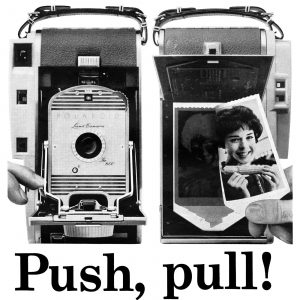In: polaroid

The Polaroid Book : Selections from the Polaroid Collections of Photography
January 5, 2023The Polaroid Book : Selections from the Polaroid Collections of Photography
Edited by Steve Crist, Essay by Barbara Hitchcock
Taschen 2005

As a photographer, and especially as one who has shot a lot of instant film, I could wax poetic about the wonders of the Polaroid film process; that it was invented in 1947 by Edwin Land and his Polaroid Corporation; that he formed a partnership with Ansel Adams to explore the artistic capabilities of the medium in 1948; that Land and the Corporation made hundreds of cameras and film available to artists around the world on the condition that they gave some of their images to Polaroid’s collection of photos. I could tell you that it was THE photographic medium of the 50’s, 60’s, 70’s and 80’s and that creating a photo was indeed as easy as “Push, pull!”. However, there are so many writers and photographers out there who have extolled the virtues of the process over the last 75 years that I can’t possibly say anything new.
The Polaroid Book : Selections from the Polaroid Collections of Photography tells the story in 254 photographs by 203 artists. The photos include black and white documentary and landscape images taken with the cumbersome early models of the Polaroid line of cameras to incredibly immersive large format color images made by celebrated artists and fashion photographers. The creativity in these polaroids is boundless. From Adams to Warhol with a little Close and Hockney in between, Polaroids were a tool used by well (and lesser) known artists to create stunning pieces of work. Chuck Close’s Self-portrait (seen below) stands out; a mosaic made up of 9 separate images to create a large, somewhat disjointed selfie in Close’s trademark (and usually painted) style.
Perusing this book will lead you to want to try capturing this photo-magic yourself, which you can do by using Fujifilm’s Instax line of film and cameras. Anecdotal evidence points to these colourful, well designed cameras acting as lures to teens everywhere to further explore the possibility available to them in analog photography as a creative outlet. It is one of the reasons that film sales are quickly growing again after years of domination of the market by digital photography.
The Polaroid Book is available from numerous online and bricks-and-mortar retailers.
~ Mark Walton
Read More
Christina Z. Anderson – Cyanotype: The Blueprint in Contemporary Practice
June 25, 2021Christina Z. Anderson
Cyanotype: The Blueprint in Contemporary Practice
A Focal Press Book, Routledge
Cyanotype: The Blueprint in Contemporary Practice is THE book you need if you want to learn how to create stunning cyanotype prints. Written by Christina Z. Anderson and available online, it offers detailed notes on formulas, papers, digital negatives and the actual process itself, as well as highlighting the work of contemporary cyanotype artists. Anderson is also the author of similar books on gum prints and salted paper prints. I’ve included 2 of my test images using her processes below. ~ Mark Walton
Read More
Patti Smith – Land 250
June 3, 2021Patti Smith
Fondation Cartier pour l’art contemporain
Currently Out of Print, copies available on Amazon or at specialty bookstores.
Patti Smith Land 250 is a collection of images taken by the legendary musician/artist/poet using her beloved Polaroid 250. The 250 camera creates instant images using polaroid (and later Fujifilm) peel apart instant black and white or colour film, whose production was discontinued in 2016. The camera is unforgiving, relying on a small electronic sensor to automatically set exposure, leaving the photographer only to select focus and composition. Smith plays it like a violin, coaxing romantic, sonorous photos of everything from a taxidermized bear to the gravesite of Yeats.
There is a beauty in the photographs that comes from both the subject matter she chooses but also inherent to the time period in which the camera was created. It is a tool of the 1960’s and reminds us, like all photography, of things past, frozen for an instant and captured for posterity.
~ Mark Walton
Read More
Recent Comments